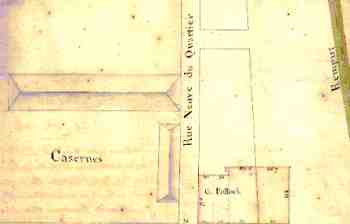

 | 
|
| This old home was the residence of E. H. Park during the early part of this century. Located at 4557 North Peters Street, it was adjacent to the second Ursuline Convent (the tower rising above the tree tops belongs to one of the convent buildings). Both the residence and the convent were later demolished to allow for construction of the Industrial Canal, which opened to water-borne traffic in 1923. [Louisiana Postcard Collection: Residential Buildings] | This 1898 graduation invitation (see detail, above) reminds us that Southern University began providing higher education to the African American community in New Orleans decades before moving to its present campus in Baton Rouge. The old Southern buildings on Magazine and Soniat Streets later housed Xavier University until that institution moved to Washington Avenue in 1932.. Xavier Prep now operates on the site, continuing the tradition of educational service to the black youth of the Crescent City. [Rare Vertical File: Invitations--Commencement] |
| City Attorney E. A. Sullivan's 1893 letter to the Mayor and City Council reminds us that the city's image was badly tarnished when an angry mob of "respected citizens" lynched a number of Italians who had been acquitted of charges that they had assassinated Police Chief David Hennessey. Some observers have even suggested that war between Italy and the United States over the issue was a real possibility as a result of the incident at the old Parish Prison. [City Archives. City Council Records] | |
|
 | 
|
| Spanish Fort, on the shore of Bayou St. John at Lake Pontchartrain, was a popular resort for New Orleanians during the nineteenth and early twentieth century. This post card uses a 1912 photograph to advertise some of the delights that awaited anyone who rode the streetcar out to the end of the bayou. All that remains of the resort are the ruins of the colonial fortification that gave its name to the area. The amusement park moved to the end of Elysian Fields Avenue in the 1930s; we remember it well as Pontchartrain Beach. [Louisiana Postcard Collection: Bayou St. John] | An unidentified residential street, showing streetcar tracks under construction, 1895, reminding us of the complex web of tracks that once weaved its way through the city. In 1880, there were 141 miles of street railway tracks in New Orleans; in 1890, there were 177.2 miles. Today, only the St. Charles Avenue and Riverfront lines remain, but progress is being made toward returning the cars to Canal Street. Perhaps the old saying, "What goes around comes around" is not such a cliche after all. (Note also the old street light, upper left). [Louisiana Photograph Collection. Civil District Court Collection: evidence filed in Civil District Court # 47295, E. St. Amant vs. New Orleans Railroad Co.] |
| 13,385 of the city's 168,675 residents in 1860 were enslaved persons. This 1903 petition to the mayor and City Council identifies four former slaves who still lived in the city forty years after the Emancipation Proclamation. [City Archives. City Council Records] | |
|
 | 
|
| A capacity crowd in the old Tulane Stadium to see the Sugar Bowl, thirty-fifth anniversary of the Classic, January 1, 1969. The final Sugar Bowl was played in the old stadium on January 1, 1974; the next year the Sugar Bowl (and Tulane and New Orleans Saints football games) moved to the Superdome, where the Sugar Bowl continues to draw capacity crowds and to pump millions into the New Orleans economy. Looking back at this photograph now, we have to wonder, "Where did all those people park?" [Louisiana Photograph Collection. General Interest Collection] | Barthelemy Lafon's 1804 plan shows the location of the barracks (casernes) that gave their name to the Rue de la Quartier (Barracks Street). The military vacated the casernes in 1834, when present-day Jackson Barracks opened. The owners of the property demolished the buildings shortly afterwards. [City Archives. Letters, petitions and decrees of the Conseil de Ville] |
| In this letter, James Freret, a prominent local architect, describes the North Rampart Street home of the Union Francaise, one of several French societies active in the city long after New Orleans had become American. The French Union Hall is now gone, its place taken by the Landmark Hotel following its destruction by fire. The Louisiana Division houses the manuscript records of the Union Francaise. [City Archives. City Engineer's Office Records] | |
|
Return to Beginning of Exhibit